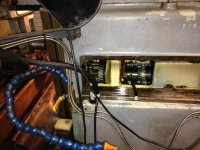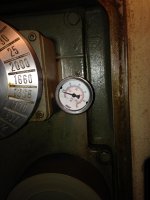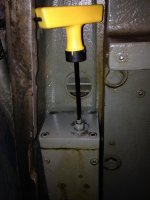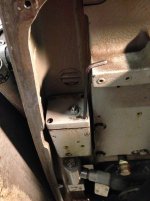Spindle delay and interlock pressure adjustment
Checking the spindle delay and interlock pressure is easy: install a gauge in the correct place and see if you have the right pressures. It should read 0 psi before the spindle start button is pressed. Then 25 to 30 psi for a couple of seconds. Then it should rise to full column pressure (200+ psi) over a couple more seconds. So you need a 300 psi gauge for just the quick check.
My junk Home Depot air compressor gauge wouldn't even read 0 correctly. The 300 psi Wika gauge I got from Amazon, however, indicated that the delay pressure was below 10 psi.
To actually adjust the interlock pressure, you have to hold the mill in the 25 to 30 psi stage mentioned above without letting it proceed to the 200 psi following stage. The manual says the low pressure stage is to engage the gears gently in case they are out of alignment.
The way to hold the mill in the interlock stage is to physically prevent the gears from engaging by using a half collar on one of the gear shafts. The half collar prevents one particular gear from sliding into position, keeping the spindle in neutral. Dimensions for the collar are given on page 13 of SM-66, the maintenance manual available at vintage machinery dot org.


The neutral lock is installed through the opening behind the spindle access cover on the right side of the mill. It goes on the splined shaft under the spindle shaft in the rear half of the column, in between the gear and the dividing wall. Notice that although the lower shaft is spinning, the splined shaft that the neutral lock is on is not moving.

With the neutral lock in place, it was safe to install a 60 psi gauge in the spindle delay and interlock pressure port. This gives much better resolution and accuracy than a 300 psi gauge for the low pressure adjustment that is required. My interlock pressure was only 7.5 psi.

The interlock pressure adjustment is the set screw and lock nut on the cap that was removed so many times to get the constant pressure right. This is a much nicer adjustment method than using shims.
Adjusting this was easy, except that it didn't want to be in the range between 25 and 35 psi. Below was ok; above was ok; in the range was not happening. I finally left my pressure at about 37 psi.
After removing the neutral lock and pressure gauge and replacing the spindle access cover (oil flies everywhere when the gears driving the spindle are moving), all speeds come on within 5 seconds or so.


Only a little oil splashed out for the ten or so minutes I had the neutral lock was installed. The gears in the upper column weren't spinning, so very little was flung out the opening.
One more post to follow with a few pictures of the neutral lock.

















